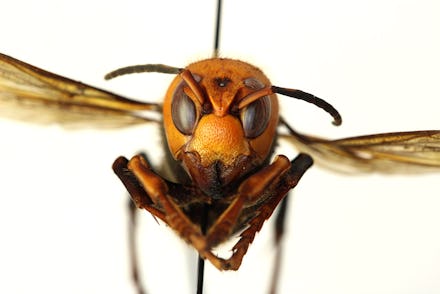Everything you need to know about the "murder hornets" terrorizing Washington State

This year has already presented us with a lot of existential threats, from a global pandemic to the potential existence of aliens with highly advanced UFOs, but over the weekend Americans were introduced to a new one: “murder hornets.” Officially known as Asian giant hornets, the insects recently appeared in the state of Washington and have already made their presence felt by decapitating their prey and turning local bee colonies into scenes from CSI: Special Insects Unit. So where do these killers belong on the Threat Down list? Here is everything you need to know about murder hornets.
Where do murder hornets come from?
The murder hornet typically calls regions of East Asia, South Asia, and Mainland Southeast Asia its home. The insect was most commonly found in rural regions of Japan. The killers usually live in low mountain and forest regions, where they nest by digging into the ground. They typically choose to avoid plains and more high-altitude settings.
How did they get to the United States?
That's not entirely clear at this point. The first sighting of the murder hornet in the US came in December 2019, when a beekeeper came across a dead one sitting on his front porch. The discovery was quickly reported to the state's authorities, and they found at least one other instance of a beekeeper discovering a murder hornet in the region, but it wasn't clear then just how widespread the invasion might be. Queens of murder hornet nests typically end their hibernation period in April, meaning the hives will become more active and we'll start to get a better idea of just how many of these insects have managed to make their way to the US.
What do they look like?
The first thing that stands out about murder hornets is their size. According to the Washington State Department of Agriculture, they measure at between 1.5 to two inches in length, making them the largest type of hornet in the world. They typically have a black and yellow striped abdomen, similar to what you'd expect out of any hornet, but the face on the murder hornet is quite distinct. It's large, with an orange or yellow head and prominent eyes.
Can they kill humans?
Yes, murder hornets are capable of killing humans, but it's not as common as you might expect from something with "murder" in its name. The bug kills about 50 people per year in Japan, according to the New York Times. In one particularly bad year documented by the BBC, murder hornets killed 41 people in just three months in Northern China. During that same time period, the hornets injured another 1,600, including many who required hospitalization. Typically, murder hornets are most deadly to those who are allergic to their venom. They tend not to be aggressive toward humans and usually don't sting unless provoked or if they feel as though their nest is being threatened, which is why Washington State has advised residents not to engage with the insect.
So where does the name "murder hornet" come from?
The real threat that murder hornets pose are to other insects, particularly other bees. Asian giant hornets typically feed off other insects, and honeybee colonies are an ideal target for them. The ruthless hornets enter into what is known as a "slaughter phase," in which they quickly and ruthlessly decapitate honeybees until they have eliminated an entire hive. According to the Washington State Department of Agriculture, these colony-wide slaughter can take just a few murder hornets a matter of hours to do. Once they have killed off all of their victims, the murder hornets will defend the hive as if it is their own and use it to feed their own young.
This type of threat can be completely devastating to the honeybee population, which already is declining at an alarming rate in the United States. A survey published last year found that beekeepers saw a 40 percent drop in honeybee colonies between 2018 and 2019, and similar results have been observed around the world as climate change takes its toll on honeybee populations. The last thing the insects need is a pack of roaming, murdering hornets that can quickly and efficiently kill off entire colonies in a matter of hours. Japanese honeybees have developed defense mechanisms against the murder hornets, working together to effectively cook the killers alive when they come to attack, but it's not clear if honeybees in the US will have that same method in their arsenal.
Can they be contained?
It's hard to know just how well the murder hornet invasion can be contained. Scientists are certainly worried about it, as evidenced by the full-scale hunt they’ve launched to determine just how big of a foothold the insects have already established in the US. If the hornets become too prevalent, there really isn't much of a defense against them. The New York Post reported that beekeepers on the East Coast believe that the arrival of the murder hornets is inevitable. They are also quite skilled fliers, capable of traveling up to 20 miles per hour and covering several miles per day — though they are unlikely to make a straight beeline across the country simply to establish a presence.
While the murder hornets present a significant threat to the honeybee population of the US if they are able to establish a presence, they are not invincible. The hornets can be contained or even eliminated entirely through pest control methods, including the use of poison, controlled fires, and traps. If possible, scientists want to move quickly in order to figure out where murder hornets have established nests and take action against them to make sure the worst-case scenario — a growing, well-established murder hornet population making victims of an already shrinking honeybee population — doesn't come to fruition.